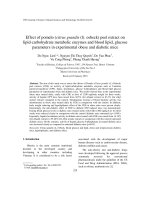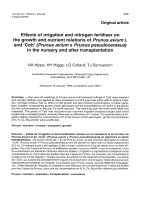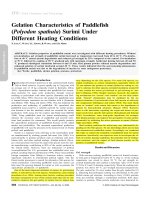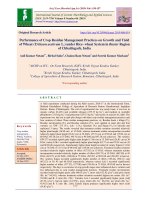Effect of irrigation and nitrogen on production potential of sorghum (Sorghum bicolor L.) under south Gujarat condition
Bạn đang xem bản rút gọn của tài liệu. Xem và tải ngay bản đầy đủ của tài liệu tại đây (191.8 KB, 6 trang )
Int.J.Curr.Microbiol.App.Sci (2019) 8(9): 1801-1806
International Journal of Current Microbiology and Applied Sciences
ISSN: 2319-7706 Volume 8 Number 09 (2019)
Journal homepage:
Original Research Article
/>
Effect of Irrigation and Nitrogen on Production Potential of Sorghum
(Sorghum bicolor L.) under South Gujarat Condition
Diksha Tajane1*, V. P. Usadadia2, Dipak Borase1 and Sangita Sawadhkar3
1
Department of Agronomy, N. M. College of Agriculture, Navsari Agricultural University,
Navsari-396450, India
2
Department Soil and Water Management Research Unit, Navsari Agricultural University,
Navsari-396450, Gujarat, India
3
Department of Agronomy, College of Agriculture, Dr. P. D. K. V, Akola- 444004, India
*Corresponding author
ABSTRACT
Keywords
Nitrogen
application, coastal
areas, irrigation
levels
Article Info
Accepted:
20 August 2019
Available Online:
10 September 2019
A field experiment entitled “Response of rabi sorghum (Sorghum bicolor L.) on different
levels of irrigation, nitrogen and banana pseudostem sap and its residual effect on summer
greengram (Vigna radiata L.) under South Gujarat condition” was carried out during rabi
season of 2016-17 and 2017-18 at college farm of Soil and Water Management Research
Farm, Navsari Agricultural University, Navsari. The soil was clayey in texture, rich in
organic carbon, medium in available nitrogen, P 2O5 and K2O with alkaline in reaction (pH
7.8). Total twelve treatment combinations, consisting of four irrigation schedule based on
IW:CPE ratio (I1=0.4, I2=0.6 and I3=0.8) and three nitrogen levels (N1= 60 kg N ha-1, N2=
80 kg N ha-1 and N3= 100 kg N ha-1) were tested in a split plot design with four
replications. The results indicated that scheduling irrigation at an IW:CPE ratio of 0.8
recorded significantly higher values of almost all the growth characters, yield attributes as
well as seed and stover yields of sorghum over 0.6 and 0.8 IW:CPE ratios and remained
statistically at par with IW:CPE ratio of 0.8. Days to 50% flowering and maturity were
delayed under this IW:CPE ratio. Whereas, higher WUE was obtained when crop was
irrigated at 0.4 IW:CPE ratio. Almost all the growth characters, yield attributes, seed and
stover yields were found significantly higher when crop has given nitrogen application at
100 kg N ha-1 than that over lower dose of nitrogen.
Introduction
A field experiment was conducted during
2016-17 to 2017-18 at college farm of Soil
and Water Management Research Farm,
Navsari Agricultural University, Navsari
Gujarat to study the effect of different levels
of irrigation and nitrogen on production
potential and profitability of Sorghum in
saline soil of coastal areas of south Gujarat.
The field experiment was laid out in split plot
technique with four replications, comprising
three levels of irrigation (0.4, 0.6 and 0.8
IW/CPE) and three nitrogen levels (60, 80 and
100 kg N ha-1). The results indicated that
scheduling irrigation at an IW:CPE ratio of 0.8
1801
Int.J.Curr.Microbiol.App.Sci (2019) 8(9): 1801-1806
recorded significantly higher values of almost
all the growth characters, yield attributes as
well as seed and stover yields of sorghum over
0.6 and 0.8 IW:CPE ratios and remained
statistically at par with IW:CPE ratio of 0.8
such as plant height at harvest, leaf area index
at 90 DAS, no. of internodes, grain yield, field
water use efficiency and sorghum equivalent
yield. Among the irrigation levels, both 0.6
and 0.8 IW/CPE were remained at par with
each other and found to be significantly
superior over 0.4 IW/CPE (I1) for growth and
yield attributing parameters Treatment I2N3
recorded significantly higher seed yield (972
kg ha-1), net realization (` 2,15,052 ha-1) and
benefit cost ratio (2.81).
Sorghum (Sorghum bicolor L.) is a drought
resistant crop among the major cereals and the
fifth most important cereal in the world after
wheat, rice, maize and barley. It is considered
as king of millets and staple food and fodder
crop of the world's poor and most foodinsecure population, located primarily in the
arid and semi-arid tropics. Sorghum grain
contains 56-73% starch, 11.3% protein and
3.3% fat. Sorghum fodder is considered as an
essential feeds for the livestock, which can
help in maintaining good health of cattle and
contains more than 50% digestible nutrients
with 8% protein, 2.5% fat and 45% nitrogenfree extract. Its dietary value is equivalent to
corn that way animals enjoy well due to its
deliciousness and juicy character (Mehmood
et al., 2008). It grown on 43.81 million ha area
in the world, producing about 65.42 million
tonnes grain with an average yield of 1523 kg
ha-1. India and USA have largest share of
global sorghum area, while the maximum
production of sorghum occur in the USA.
India presently produces about 5.54 million
tonnes of sorghum grain from area of 6.16
million ha and productivity of 884 kg ha-1.
Among the different factors affecting yield,
water management and nitrogen play an
important role for enhancing yield. Water is
the scare natural resource and availability of
irrigation water is limited therefore, irrigation
water should be utilized most efficiently by
scheduling irrigation based on IW:CPE ratio.
Application of nitrogen is another key factor
affecting yield per unit area results in lower
yield and hence optimum plant population
produces maximum yield.
Precise information regarding appropriate
schedule of irrigation and nitrogen
requirements for rabi sorghum is very limited.
Keeping in view the above considerations,
comprehensive research programme planned
to study the judicious use of irrigation water
which may provide information on not only
water use by crop but also when to irrigate and
to find out optimum nitrogen requirement for
sorghum with the following broad objectives.
For exploiting its maximum yield potentiality
and efficient utilization of light, land, water
and inputs, optimum plant population is vital
factor for rabi sorghum. Keeping in view the
above considerations, comprehensive research
programme was plan to study the judicious
use of irrigation water and to determine the
suitable dose of nitrogen for rabi sorghum
with the following broad objectives.
Materials and Methods
A field experiment was carried out during rabi
season of 2016-17 and 2017-18 at college
farm of Soil and Water Management Research
Farm, Navsari Agricultural University,
Navsari. The soil was clayey in texture, rich in
organic carbon, medium in available nitrogen,
P2O5 and K2O with alkaline in reaction (pH
7.8). Total sixteen treatment combinations,
consisting of four irrigation schedule based on
IW:CPE ratio (I1=0.4, I2=0.6 and I3=0.8) and
three row spacing (N1=60 kg N ha-1, N2= 80
kg N ha-1 and N3= 100 kg N ha-1) were tested
in a split plot design with four replications to
1802
Int.J.Curr.Microbiol.App.Sci (2019) 8(9): 1801-1806
ascertain optimum IW:CPE ratio for
scheduling irrigation, to find out optimum
nitrogen dose, to work out yield, WUE of
irrigation and nitrogen dose on yield of rabi
sorghum.
Results and Discussion
Days To 50% Flowering
The data pertaining to days to 50% flowering
as influenced by different IW:CPE ratio and
spacing are summarized in Table 1. Irrigation
scheduled at 0.4 IW:CPE ratio (I1) recorded
significantly less number of days (44.16) for
50% flowering whereas, irrigation scheduled
at 1.0 IW:CPE ratio (I3) taken significantly
more number of days (53.11) for 50%
flowering. lower dose of nitrogen at 60 kg N
ha-1 (N1) recorded significantly less number of
days (45.77) for 50% flowering whereas,
higher dose of nitrogen of 100 kg N ha-1 (N3)
taken significantly more number of days
(49.90) for 50% flowering. Hugar et al., 2010
reported that lower dose of nitrogen
application might be increase higher water and
nutrient absorbed by plants, thus decrease in
days in 50% flowering.
Days to maturity
The data regarding days to maturity on pooled
basis as influenced by different IW:CPE ratios
and nitrogen dose are presented in Table 1.
Irrigating the crop as per 0.4 IW:CPE ratio (I1)
taken significantly less number of days for
maturity (85.91) which was on par with
IW:CPE ratio of 0.6 (I2) while, sorghum
irrigated at 0.8 IW:CPE ratio (I3) took
significantly more (91.98) number of days to
maturity. Whereas minimum days to maturity
were found to be significant due to the lower
level (N1 i.e., 60 kg N ha-1) of irrigation
(84.79), Patel et al., 2010.
Length of ear head
The mean data on length of ear head as
influenced by different IW:CPE ratio and
nitrogen dose are furnished in Table 1.
Significantly the highest length of ear head of
sorghum plant (23.60 cm) was recorded when
rabi sorghum was irrigated at 0.8 IW:CPE
ratio (I3).
Significantly the lowest ear head length
(20.73) was observed under 0.4 IW: CPE ratio
(I1). Application of nitrogen of 100 kg N ha-1
(N3) produced significantly the highest ear
head length (24.28).
Significantly the lowest length of ear head
(21.40) was observed under 60 and 80 kg N
ha-1 (N1 and N2). Patel 2005 reported that
optimum availability of moisture at 0.8
IW:CPE ratio without any stress and higher
dose of nitrogen increases ear head length per
plant.
Seed yield per hectare
A perusal of data on seed yield per hectare as
influenced by different IW:CPE ratio and
nitrogen dose are furnished in Table 2. The
results revealed that significantly higher seed
yield of 3317 kg ha-1 was produced under
IW:CPE ratio 0.6 (I2) and it was found
statistically on same bar with I3. Significantly
minimum seed yield of 2734 kg ha-1 was
recorded under IW:CPE ratio 0.4 (I1). Seed
yield per hectare differed significantly due to
different levels of nitrogen. Application of
nitrogen at 100 kg N ha-1 (N3) produced
significantly higher seed yield of 3307 kg ha-1.
Significantly lower seed yield of 2763 kg ha-1
recorded under lower dose of nitrogen i.e., 60
kg N ha-1 (N1). Patel et al., 2010 found that
optimum availability of moisture at 0.8
IW:CPE ratio.
1803
Int.J.Curr.Microbiol.App.Sci (2019) 8(9): 1801-1806
Table.1 Effect of irrigation and nitrogen on days to 50% flowering, days to maturity and length
of ear head of sorghum (pooled)
Tr No.
I1
I2
I3
N1
N2
N3
Treatments
Irrigation: (I)
0.4 IW:CPE ratio
0.6 IW:CPE ratio
0.8 IW:CPE ratio
SEm±
CD (P=0.05)
CV %
Nitrogen: (N)
60 kg N ha-1
80 kg N ha-1
100 kg N ha-1
SEm±
CD (P=0.05)
CV %
Days to 50%
flowering
Days to
maturity
length of ear
head
44.16
46.81
53.11
0.68
2.09
9.77
85.91
87.41
91.98
0.76
2.35
5.98
20.73
22.75
23.60
0.25
0.76
7.61
45.77
48.40
49.90
0.47
1.33
6.83
84.79
87.70
92.80
0.65
1.82
5.08
21.40
21.40
24.28
0.19
0.54
5.99
Table.2 Effect of irrigation and nitrogen on seed yield, stover yield and field water use
efficiency (pooled)
Tr No.
I1
I2
I3
N1
N2
N3
Treatments
Irrigation: (I)
0.4 IW:CPE ratio
0.6 IW:CPE ratio
0.8 IW:CPE ratio
SEm±
CD (P=0.05)
CV %
Nitrogen: (N)
60 kg N ha-1
80 kg N ha-1
100 kg N ha-1
SEm±
CD (P=0.05)
CV %
Seed yield
(kg ha-1)
Stover yield
(kg ha-1)
Field water use
efficiency
(kg ha mm-1)
2734
3317
3185
54
166
12.11
7115
8328
8080
123
378
10.85
11.39
11.06
8.85
0.18
0.75
12.22
2763
3165
3307
33
93
7.42
7034
7950
8540
107
302
9.50
9.38
10.75
11.16
0.11
0.32
7.58
1804
Int.J.Curr.Microbiol.App.Sci (2019) 8(9): 1801-1806
Fig.1
Stover yield per hectare
The results regarding stover yield per hectare
of sorghum as influenced by different IW:CPE
ratio and nitrogen are furnished in Table 2.
Irrigation applied at 0.6 IW:CPE ratio (I2)
produced significantly higher stover yield of
8328 kg ha-1 followed by irrigating the crop at
0.8 IW:CPE ratio (I3) which produced stover
yield of 8080 kg ha-1.
Significantly lower stover yield of 7115 kg ha1
was recorded when sorghum was irrigated at
an IW:CPE ratio of 0.4 (I1). Application of
nitrogen at 100 kg ha-1 (N3) gave significantly
higher stover yield of 8540 kg ha-1.
Significantly lower stover yield of 7034 kg ha1
was recorded under 60 kg N ha-1 (N1).
Significantly higher stover yields was found in
treatment I3 (0.8 IW:CPE ratio) because of
more
photosynthesis
and
sufficient
translocation due to adequate moisture
availability.
Field water use efficiency
Data regarding water use efficiency as
influenced by different IW:CPE ratio and
irrigation are presented in Table 2. Result
revealed that as IW:CPE ratio increased from
0.4 to 0.8 the FWUE in decreasing order.
Higher FWUE of 11.39 kg ha mm-1 was
noticed when sorghum was irrigated at 0.4
IW:CPE ratio. FWUE recorded under IW:CPE
ratios of 0.6 and 0.8 were 11.06 and 8.85 kg
ha mm-1, respectively. The higher FWUE in I1
than I2 might be due to slight coincidence of
the irrigation schedules with critical stages of
crop growth and development. Results
revealed remarkable effect of nitrogen on
1805
Int.J.Curr.Microbiol.App.Sci (2019) 8(9): 1801-1806
FWUE. The mean values of FWUE recorded
with three nitrogen levels viz., N1 (60 kg N ha1
), N2 (80 kg N ha-1) and N3 (100 kg N ha-1)
were 9.38, 10.75 and 11.16 kg ha mm-1,
respectively. These results are in conformation
with the results reported by Bhuva and
Sharma., 2015.
On the basis of above summarized results, the
following conclusions have been drawn:
Increase
in
frequency
of
irrigation
significantly delayed days to 50% flowering
and maturity whereas, treatment I1 (0.4
IW:CPE ratio) noticed early flowering and
maturity followed by treatment I2 (0.6
IW:CPE ratio).
Irrigating the crop at an IW:CPE ratio of 0.8
produced significantly maximum length of ear
head.
Significantly higher seed yield and stover
yield per hectare were recorded when sorghum
was irrigated with 0.8 IW:CPE ratio (I3).
Application of higher quantity of irrigation
water reduced the water use efficiency.
Sorghum irrigated at an IW:CPE ratio of 0.4
(I1) increased the FWUE by 28.70% over 0.8
IW:CPE ratio respectively.
Higher dose of nitrogen exerted their
significant influence on days to 50% flowering
and maturity.
Significantly maximum length of ear head was
recorded under 100 kg N ha-1 (N3) over lower
dose of nitrogen (N1). Higher dose of nitrogen
recorded significantly higher seed and stover
yield recorded under 100 kg N ha-1 (N3).
References
Bhuva, H. M. and Sharma, S. (2015).
Influence of nutrient uptake by
irrigation,
nitrogen
and
phosphorus and their effect on
quality parameters of rabi pearl millet.
AmericanEurasian Journal of
Agricultural & Environment Science
15 (3): 324-327. Hugar, A. Y.,
Jayadeva, H. M., Rangaswamy, B. R.,
Shivanna, S. and Chandrappa, H.
(2010).
Assessing the effect of
nitrogen and harvesting stages on yield
and yield attributes of sweet sorghum
genotypes. Agricultural Science Digest
30 (2): 139-141.
Mehmood, S., Bashir, A., Amad, A., and
Akram,
Z.
(2008).
Molecular
characterization of
regional
Sorghum bicolor varieties from
Pakistan.
Pakistan
Journal
of
Biological 40: 2015-2021.
Patel G. J. (2005). Effect of irrigation and
chemical
fertilizer
along
with
biofertilizer on crop production
of
maize (Zea maize L.), Ph. D. Thesis
submitted to AAU, Anand.
Patel, M. R., Meisheri, T. G. and Sadhu, A. C.
(2010). Effect of irrigation, nitrogen
and biofertilizer on forage yield
and quality of oat (Avena sativa L.).
Forage Research 35 (4):
231-235.
How to cite this article:
Diksha Tajane, V. P. Usadadia, Dipak Borase and Sangita Sawadhkar 2019. Effect Of
Irrigation and Nitrogen on Production Potential of Sorghum (Sorghum bicolor L.) under South
Gujarat Condition. Int.J.Curr.Microbiol.App.Sci. 8(09): 1801-1806.
doi: />
1806







![Mapping of quantitative trait loci (QTLS) associated with sugarcane aphids resistance in recombinant inbreed population of sorghum [Sorghum bicolor (L.) Moench]](https://media.store123doc.com/images/document/2020_01/09/medium_jrk1578566578.jpg)

